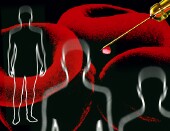
WEDNESDAY, Feb. 2 (HealthDay News) — Researchers report that DNA analysis has led to the identification of a new and extremely rare vascular disease, along with its genetic cause.
As described in the Feb. 3 issue of the New England Journal of Medicine, the debilitating, painful and progressive disease is defined by the calcification of arteries in both the hands and feet of patients, and in the vascular network below the waist. Arteries of the heart remain unaffected.
Labeling it “ACDC,” the U.S. National Institutes of Health (NIH) research team has linked the disease’s tell-tale calcium build-up to a deficiency in a protein called CD73. And while the disorder bears some symptoms in common with rheumatoid arthritis (such as leg and joint pain), the study authors stress that it is a wholly new disease.
“This is the first novel disease discovery identified through the collaborative and interdisciplinary approach employed by clinical researchers in the NIH Undiagnosed Diseases Program,” NIH director Dr. Francis S. Collins said in an NIH news release. “This disorder previously baffled the medical field and evaded diagnosis when conventional methods were used.”
To date, ACDC has been diagnosed in exactly nine living patients from three unrelated families, among whom the disorder has been linked to a mutation in the so-called “NT5E” gene. Five of the patients are siblings from a single family, and all five bore the NT5E mutation.
Over the past 100 years, seven additional cases bearing similarities to the nine cases currently cited have been reported, but none of those led to a clear diagnosis of the newly identified condition.
The nine patients in the current study sought care for pain and cramping in their calves, thighs, buttocks and feet. Calcium build-up in arterial walls was subsequently uncovered.
Surgery to redirect blood flow to different arterial passages was conducted in one case, along with amputation of the foot.
The researchers expressed hope that, having pinpointed the genetic roots of the disease, they can now develop better treatments for such patients.
More information
For the more information on ACDC, visit the U.S. National Human Genome Research Institute.

